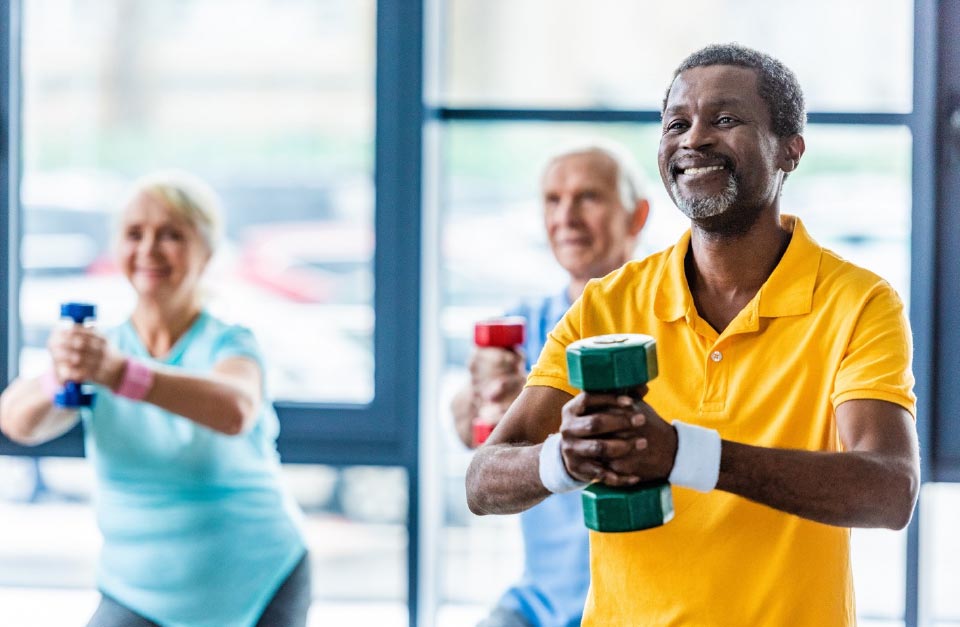Common Orthopedic Issues in People Over 40
Orthopedic issues can happen at any age. But as people enter middle age, the chances of having an orthopedic injury can increase. It’s important for people in their 40s and beyond to stay active as part of a healthy lifestyle. However, physical fitness activities that used to be easy in one’s 20s and 30s can be more difficult as the years pass. In fact, acute injuries and chronic joint pain are two reasons middle-aged people decide to schedule an appointment with an orthopedic specialist.

Many men and women who are over 40 years old have been working in front of computers for much of their working life. This has contributed to a more sedentary lifestyle than during previous decades. According to the CDC, adults should get at least 150 minutes per week of moderate-intensity aerobic activity and two or more days of muscle-strengthening activities that work all major muscle groups (legs, hips, back, abdomen, chest, shoulders, and arms). However, this level of activity can be very difficult for people suffering from an orthopedic injury and pain.
What are common orthopedic injuries?
There are many common orthopedic injuries. These injuries can cause acute and chronic pain. Some of the most common orthopedic injuries for people in their 40s include:
Herniated Discs
A herniated disc is a common injury that can affect any part of the spine. A herniated disc can cause severe pain and other problems in the arms or legs.
Rotator Cuff Tear
The rotator cuff is a group of muscles and tendons in each shoulder. It holds your upper arm bone in your shoulder socket. It keeps your arm stable while allowing it to lift and rotate. Too much stress on the rotator cuff can cause a tear. This can be a painful injury.
Anterior Cruciate Ligament Tear (ACL Tear)
This injury is a tearing of the ACL ligament in the knee joint. The ACL ligament is one of the bands of tissue that connects the femur to the tibia. An ACL tear can be painful. It can cause the knee to become unstable.
Meniscus Tear
This is a common injury of the knee. Your knee joint is cushioned by two c-shaped wedges of cartilage called the "menisci." Each individual cushion is called a "meniscus." This injury is a tear of one of these cushions.
Pain, numbness and tingling in your hand may be from carpal tunnel syndrome. It happens when the area around the main nerve to your hand is too tight. The nerve is called the median nerve. And the small space in your wrist where it passes is called the carpal tunnel.
Plantar Fasciitis
Plantar fasciitis is an irritation of the plantar fascia. This thick band of connective tissue travels across the bottom of the foot between the toes and the heel. It supports the foot's natural arch. It stretches and becomes taut whenever the foot bears weight.
How can I avoid orthopedic issues?
Prevention is important. The doctors at CAO recommend protecting your bones and muscles by practicing a healthy lifestyle. This includes getting proper nutrition, exercising regularly, and maintaining a healthy weight. People who played sports in their younger days may have experienced sport-related injuries such as strains, sprains, or torn ligaments. Even if these injuries were fixed properly with surgery, rest, or physical therapy, there is a good chance that these old injuries can cause chronic joint pain as the years go by.
One of the easiest ways to avoid further orthopedic issues is to take up low-impact sports such as swimming, rowing, cycling, walking, and hiking. Tai chi and yoga are also great low-impact activities for people of all ages.
What are the treatment options for orthopedic issues?
The first step to take after an injury is to seek expert medical help. An orthopedic doctor will perform a physical examination and usually order imaging such as a digital X-Ray in order to get a better look at the problem. Treatment options for orthopedic issues include simple solutions such as R.I.C.E. (Rest, Ice, Compression, and Elevation). Or a patient might need physical therapy, cupping, or dry needling. For more severe orthopedic issues, the doctor might recommend surgery. Fortunately, orthopedic surgeons are specially trained and have the highest level of expertise to fix problems with joints and bones.
Joint aches, pain, and stiffness are bound to increase as we age. But with a healthy lifestyle, regular exercise, and a variety of treatment options, you can stay active through your 40s and beyond.

